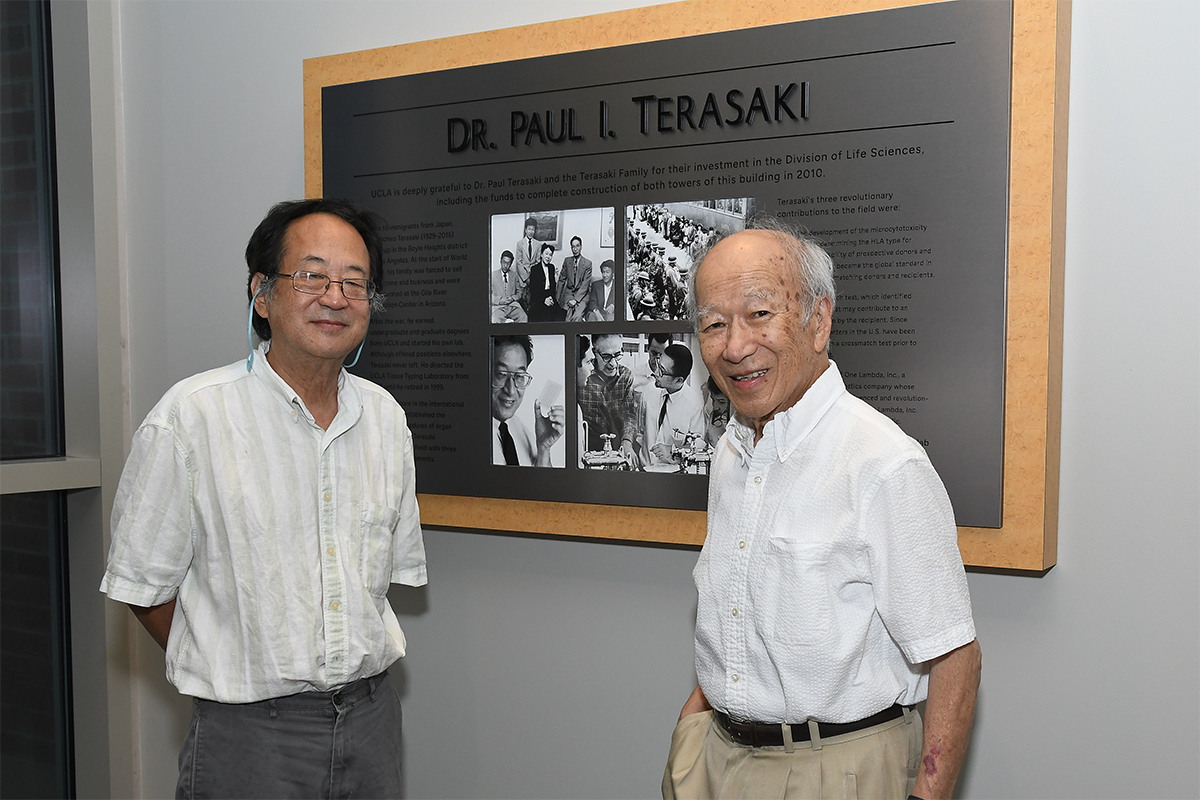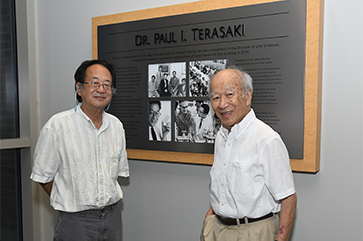Celebrating Paul Terasaki: world-changing scientist and consummate Bruin
In honor of his father, Mark Terasaki announces a $500,000 endowment to support UCLA Life Sciences graduate education

Vince Bucci
A plaque honoring the late Paul Terasaki was unveiled in the West Tower of the Terasaki Life Sciences Building. Attending the celebration were (left to right) Terasaki’s son, Mark, chairman of the Terasaki Innovation Center, and Terasaki’s brother, Richard.
By Jonathan Riggs | October 18, 2024
For someone so modest in character, Dr. Paul Terasaki’s legacy looms large — even larger than the life sciences building on UCLA’s campus that proudly bears his family’s name.
To commemorate him and his entire family, the UCLA Division of Life Sciences held a celebration Sept. 10, unveiling a new plaque that highlights Terasaki’s life, discoveries and dedication to the Bruin community.
“Today, on what would have been Paul’s 95th birthday, we honor his leadership, his impact on the scientific and medical fields, and his transformative generosity,” said Tracy Johnson, dean of life sciences at UCLA. “We dedicate this plaque, which will enlighten countless visitors to the West Tower of the Terasaki Life Sciences Building, to the memory of this remarkable man.”
That memory is truly impressive. Terasaki went from spending three years with his family in an internment camp during World War II to becoming a triple Bruin, globally respected UCLA professor and pillar of the campus, scientific and medical communities. With his family, he went on to donate more than $58 million to UCLA to spearhead and support initiatives across campus.
“It isn’t easy to say just a few words about Paul Terasaki. He was an unassuming, quiet man who left giant footprints all over the emerging fields of histocompatibility and transplantation,” said David Gjertson, adjunct professor of biostatistics and pathology at UCLA, sharing a tribute written by Michael Cecka, professor emeritus at the UCLA Immunogenetics Center. “He received the UCLA Medal in 2012. It was his most treasured honor. The students at UCLA’s graduation ceremony chanted ‘Ter-a-sa-ki’ in a modified eight-clap cadence.”
Cecka’s tribute included the story of how an unsuccessful kidney transplant in 1964 inspired Terasaki to ask for blood samples from the donor and recipient, which led him to make the revolutionary discovery that antibodies could cause transplantation rejection. In addition to developing the test that has been the international standard method in organ transplantation for the last half century, Terasaki founded the transplant diagnostic company One Lambda with eight of his former students.
George Ayoub, a fellow Bruin and former CEO and president of One Lambda who started as a technician in Terasaki’s laboratory, shared a tribute.
“I was always inspired by Dr. Terasaki’s love for innovation and his vision for the future. Even with his great achievements and successes, he maintained his modesty and rapport with everyone who worked with him,” Ayoub said. “It was an honor to work with Dr. Terasaki for over 40 years, both as a person and as a distinguished scientist.”
Fittingly for such a dedicated Bruin, Terasaki and his wife Hisako instilled this tradition in their family, with three of their children becoming alumni: Mark, Keith and Emiko Terasaki spent a combined total of 22 years at UCLA earning multiple degrees.
When the plaque was being created, Mark Terasaki, an associate professor of cell biology at the University of Connecticut, and Ricardo Ordóñez, president of the Terasaki Innovation Center, offered valuable insight into how it could most fully honor Paul Terasaki’s life and discoveries.
In addition to celebrating Terasaki, the plaque pays tribute to the collaborations and collaborators that helped make his breakthroughs and philanthropy possible.
“My father did groundbreaking work in transplant immunology, but we should also recognize all the people in his lab and One Lambda who made it happen,” said Mark Terasaki. “So accordingly, I am happy to announce the Paul I. Terasaki Endowment for Graduate Excellence in Life Sciences, a $500,000 endowment to support graduate education.”
Noting that Terasaki’s ripple effect continues to this day, Mark Terasaki closed with his wish for the future.
“We hope that the graduate endowment, the new plaque and the continuing research can further my father’s legacy,” he said, “and that his life and work can serve as an inspiration for people in the biological sciences and beyond.”
Dean Tracy Johnson echoed his sentiment as she adjourned the dedication and invited guests to close the evening with a celebratory reception and dinner.
“Ultimately, this gift is going to further discovery, innovation, collaboration, teaching, research and education — all of it rooted in the Terasaki Life Sciences Building — that will impact the world, just as Paul Terasaki did,” she said. “I’d like to extend my gratitude, not only to you, Mark, but to the entire Terasaki family for their unwavering dedication to science as well as to the training of the next generation of scientists, students and leaders.”
“Not only on his birthday, but every day,” she concluded, “our hope is that Paul’s memory will inform our shared vision of discovery, dedication and compassion.”




